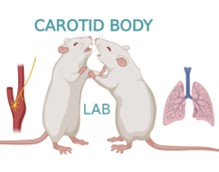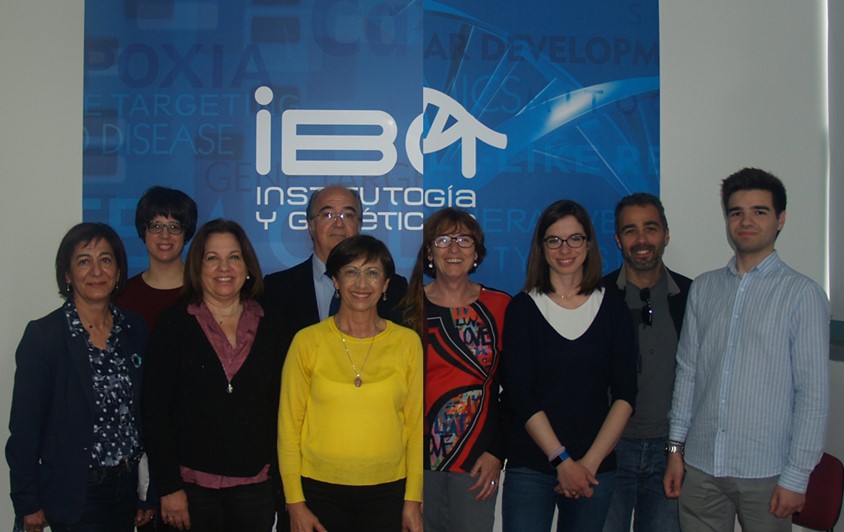Fisiología y Fisiopatología de la sensibilidad al oxígeno
I.P. Asunción Rocher
Trayectoria del grupo:
El grupo de Quimiorreceptores Arteriales de la Universidad de Valladolid se formó hace más de 40 años bajo la dirección del Prof. Constancio González junto con tres investigadores noveles, Ana Obeso, Ricardo Rigual y Laura Almaraz, incorporándose, unos años después, otros doctorandos: Asunción Rocher, Ángela Gómez-Niño, José Ramón López y Teresa Pérez-García.

Desde entonces, la actividad investigadora del grupo se ha centrado en el área de la quimorrecepción arterial y en el control respiratorio, investigando los mecanismos iónicos, celulares y moleculares implicados en la activación del cuerpo carotídeo (CC) por la hipoxia aguda y los procesos de detección-transducción-neurotransmisión involucrados en la homeostasis del oxígeno y en otros procesos regulados por el CC (acidosis, insulina, glucosa, presión arterial), con gran reconocimiento a nivel nacional e internacional.
Actualmente, la actividad del grupo se centra en el estudio de los efectos adaptativos y maladaptativos desencadenados por la hipoxia crónica, tanto sostenida como intermitente, a través de la sobreactivación del CC y del Sistema Nerviosos autónomo y su contribución en la generación de patologías respiratorias, cardiovasculares y cáncer con objeto de mejorar el diagnóstico y el tratamiento de las enfermedades respiratorias.
Estudiamos el control respiratorio mediante enfoques multiescala que abarcan desde el órgano a la molécula. A nivel de sistema, estudiamos las adaptaciones ventilatorias y cardiovasculares en situaciones de hipoxia crónica asociadas a las enfermedades respiratorias. A nivel celular, nos centramos en cómo el cuerpo carotídeo y su función se modifican el contexto de las enfermedades respiratorias.

Para ello utilizamos modelos animales preclínicos con exposición a diferentes tipos de hipoxia que reproducen algunas alteraciones en la homeostasis del O2, para entender situaciones clínicas de relevancia socio-sanitaria y económica como son la hipoxia crónica sostenida padecida por los enfermos de EPOC y los trastornos derivados de la hipoxia intermitente ocasionada por la apnea obstructiva del sueño, origen de trastornos como la hipertensión arterial y la tumorigénesis espontánea y, más recientemente, estudiamos las repercusiones de la apnea obstructiva del sueño gestacional en la descendencia de las madres con AOS.
Principales líneas de Investigación:
Durante los últimos 20 años el grupo ha publicado múltiples publicaciones que se centran, principalmente, en tres líneas de investigación:
- Línea 1: Mecanismos celulares de la sensibilidad al oxígeno en el cuerpo carotídeo y las células de músculo liso de arteria pulmonar.
- Línea 2: Fisiopatología de la Apnea Obstructiva del Sueño (AOS) y sus consecuencias adversas respiratorias, cardiovasculares, metabólicas y cáncer: estudio multiparamétrico en un modelo animal en Hipoxia Crónica Intermitente. Fisiopatología de la AOS gestacional en la descendencia.
- Línea 3: Fisiopatología de la hipoxia crónica sostenida. Caracterización de la Hipertensión Pulmonar asociada a hipoxia crónica en un modelo de rata: estudio hemodinámico, caracterización vascular y dimorfismo sexual. Caracterización del Síndrome de overlap (EPOC+AOS)
Integrantes del grupo:
Investigadores Doctores:
ASUNCIÓN ROCHER

ELENA OLEA FRAILE

JESÚS PRIETO-LLORET

Doctorandos y Alumnos Pre-Grado:
ESTHER VALVERDE PÉREZ

VÍCTOR MÍNGUEZ VELASCO

Investigadores Asociados:
- Ana Obeso Cáceres: Profesora Emérita
- Ricardo Rigual Bonastre: Catedrático Universidad
- Ángeles Gómez-Niño: Catedrática Escuela Universitaria
- Elvira González-Obeso: Médico Anatomo-Patóloga en HCUV
Publicaciones en los últimos 10 años:
- Inflammation, nitro-oxidative stress and altered autonomic outflow in obstructive sleep apnoea: an assault on homeostasis. Rocher A, Aaronson PI. J Physiol. 2023 Dec;601(24):5465-5466. doi: 10.1113/JP284946. Q1.
- Effects of Gestational Intermittent Hypoxia on Placental Morphology and Fetal Development in a Murine Model of Sleep Apnea. Valverde-Pérez E, Prieto-Lloret J, Gonzalez-Obeso E, Cabero MI, Nieto ML, Pablos MI, Obeso A, Gomez-Niño A, Cárdaba-García RM, Rocher A, Olea E. Adv Exp Med Biol. 2023; 1427:73-81. doi: 10.1007/978-3-031-32371-3_8. Q2
- Intermittent Hypoxia and Diet-Induced Obesity on the Intestinal Wall Morphology in a Murine Model of Sleep Apnea. Valverde-Pérez E, Olea E, Obeso A, Prieto-Lloret J, Rocher A, Gonzalez-Obeso E. Adv Exp Med Biol. 2023; 1427:89-97. doi: 10.1007/978-3-031-32371-3_10. Q2.
- Chronic Intermittent Hypoxia-Induced Dysmetabolism Is Associated with Hepatic Oxidative Stress, Mitochondrial Dysfunction and Inflammation. Fernandes JL, Martins FO, Olea E, Prieto-Lloret J, Braga PC, Sacramento JF, Sequeira CO, Negrinho AP, Pereira SA, Alves MG, Rocher A, Conde SV. Antioxidants (Basel). 2023;12(11):1910. doi: 10.3390/antiox12111910. Q1
- Analysis of ATG4C function in vivo. Tamargo-Gómez I, Martínez-García GG, Suárez MF, Mayoral P, Bretones G, Astudillo A, Prieto-Lloret J, Sveen C, Fueyo A, Engedal N, López-Otín C, Mariño G. Autophagy 2023; 19(11):2912-2933. Q1
- Chronic Metformin Administration Does Not Alter Carotid Sinus Nerve Activity in Control Rats. Sacramento JF, Melo BF, Prieto-Lloret J, Conde SV. Adv Exp Med Biol. 2023; 1427:203-208. Q2.
- Effect of Carotid Body Denervation on Systemic Endothelial Function in a Diabetic Animal Model. Cabral MD, Martins FO, Martins IB, Melo BF, Sacramento JF, Conde SV, Prieto-Lloret J. Adv Exp Med Biol. 2023; 1427:115-125. Q2.
- Oxygen Sensing: Physiology and Pathophysiology. Aaronson PI, Rocher A. Antioxidants 2022, 11(5), 1018. Q1(D1).
- Analysis of Bone Histomorphometry in Rat and Guinea Pig Animal Models Subject to Hypoxia. Usategui-Martín R, del Real A, Sainz-Aja JA, Prieto-Lloret J, Olea E, Rocher A, Rigual RJ, Riancho JA, Pérez-Castrillón JL. Int. J. Mol. Sci. 2022, 23(21), 12742. Q1
- Maladaptive pulmonary vascular responses to chronic sustained and chronic intermittent hypoxia in rat. Prieto-Lloret J, Olea E, Gordillo A, Docio I, Obeso A, Gomez-Niño A, Aaronson PI, Rocher A. Antioxidants 2022, 11(1):54. Q1(D1)
- Molecular Mechanisms Involved in Hypoxia-Induced Alterations in Bone Remodeling. Usategui-Martín R, Rigual R, Ruiz-Mambrilla M, Fernández-Gómez JM, Dueñas A, Pérez-Castrillón JL. Int J Mol Sci. 2022; 23(6):3233. Q1
- Type 2 diabetes progression differently affects endothelial function and vascular contractility in the aorta and the pulmonary artery. Melo BF, Prieto-Lloret J, Cabral MD, Martins FO, Martins IB, Sacramento JF, Ruivo P, Carvalho T, Conde SV. (2021). Sci Rep. 11(1):6052. Q1
- Physiology and Pathophysiology of Oxygen Sensitivity. Fitzgerald R, Rocher A. Antioxidants 10, 7. 10.3390/antiox10071114 Q1
- Chronic Intermittent Hypoxia Induces Early-Stage Metabolic Dysfunction Independently of Adipose Tissue Deregulation. Martins FO, Sacramento JF, Olea E, Melo BF, Prieto-Lloret J, Obeso A, Rocher A, Matafome P, Monteiro EC, Conde SV. Antioxidants (Basel). 2021;10(8):1233. Q1.
- Exploring the Mediators that Promote Carotid Body Dysfunction in Type 2 Diabetes and Obesity Related Syndromes. Sacramento JF, Andrzejewski K, Melo BF, Ribeiro MJ, Obeso A, Conde SV. Int J Mol Sci. 2020; 21(15):5545. Q1
- A2 Adenosine Receptors Mediate Whole-Body Insulin Sensitivity in a Prediabetes Animal Model: Primary Effects on Skeletal Muscle. Sacramento JF, Martins FO, Rodrigues T, Matafome P, Ribeiro MJ, Olea E, Conde SV. Front Endocrinol 2020; 11:262. Q1
- Peripheral Dopamine 2-Receptor Antagonist Reverses Hypertension in a Chronic Intermittent Hypoxia Rat Model. Olea E, Docio I, Quintero M, Rocher A, Obeso A, Rigual R, Gomez-Niño A. Int J Mol Sci. 2020; 21(14):4893. Q1
- Contribution of adenosine and ATP to the carotid body chemosensory activity in ageing. Sacramento JF, Olea E, Ribeiro MJ, Prieto-Lloret J, Melo BF, Gonzalez C, Martins FO, Monteiro EC, Conde SV. J Physiol. 2019; 597(19):4991-5008. Q1
- Hydroxycobalamin Reveals the Involvement of Hydrogen Sulfide in the Hypoxic Responses of Rat Carotid Body Chemoreceptor Cells. Gallego-Martin T, Prieto-Lloret J, Aaronson PI, Rocher A, Obeso A.. Antioxidants (Basel) 2019; 8(3). Q1
- Adrenal Medulla Chemo Sensitivity Does Not Compensate the Lack of Hypoxia Driven Carotid Body Chemo Reflex in Guinea Pigs. Olea E, Gonzalez-Obeso E, Agapito T, Obeso A, Rigual R, Rocher A, Gomez-Niño A. Adv Exp Med Biol. 2018; 1071:167-174. Q2
- Guinea Pig as a Model to Study the Carotid Body Mediated Chronic Intermittent Hypoxia Effects. Docio I, Olea E, Prieto-LLoret J, Gallego-Martin T, Obeso A, Gomez-Niño A, Rocher A.. Front Physiol. 2018; 9:694. Q1
- Mitochondrial Complex I Dysfunction and Peripheral Chemoreflex Sensitivity in a FASTK-Deficient Mice Model. Gomez-Niño A, Docio I, Prieto-Lloret J, Simarro M, de la Fuente MA, Rocher A. Adv Exp Med Biol. 2018; 1071:51-59. Q2
- High fat diet blunts the effects of leptin on ventilation and on carotid body activity. Ribeiro MJ, Sacramento JF, Gallego-Martin T, Olea E, Melo BF, Guarino MP, Yubero S, Obeso A, Conde SV (2018) J Physiol. 2018; 596(15):3187-3199. D1
- Role of reactive oxygen species and sulfide-quinone oxoreductase in hydrogen sulfide-induced contraction of rat pulmonary arteries. Prieto-Lloret J, Snetkov VA, Shaifta Y, Docio I, Connolly MJ, MacKay CE, Knock GA, Ward JPT, Aaronson PI. Am J Physiol Lung Cell Mol Physiol. 2018; 314(4): L670-L685. D1
- l-Phenylalanine Restores Vascular Function in Spontaneously Hypertensive Rats Through Activation of the GCH1-GFRP Complex. Heikal L, Starr A, Hussein D, Prieto-Lloret J, Aaronson P, Dailey LA, Nandi M. JACC Basic Transl Sci. 2018; 3(3):366-377. Q1
- Bioelectronic modulation of carotid sinus nerve activity in the rat: a potential therapeutic approach for type 2 diabetes. Sacramento JF, Chew DJ, Melo BF, Donegá M, Dopson W, Guarino MP, Robinson A, Prieto-Lloret J, Patel S, Holinski BJ, Ramnarain N, Pikov V, Famm K, Conde SV. Diabetologia 2018; 61(3):700-710. D1
- Guinea Pig Oxygen-Sensing and Carotid Body Functional Properties. Gonzalez-Obeso E, Docio I, Olea E, Cogolludo A, Obeso A, Rocher A and Gomez-Niño A. Front Physiol. 2017; 8:285.
- Hydrogen Sulfide as an O2 Sensor: A Critical Analysis. Prieto-Lloret J, Aaronson PI. Adv Exp Med Biol. 2017; 967:261-276. Q2
- Intermittent hypoxia mimicking sleep apnoea increases spontaneous tumorigenesis in mice. Gallego-Martin T, Farré R, Almendros I, Gonzalez-Obeso E, Obeso A. Eur Respir J. 2017; 15:49(2).
- Functional abolition of carotid body activity restores insulin action and glucose homeostasis in rats: key roles for visceral adipose tissue and the liver. Sacramento JF, Ribeiro MJ, Rodrigues T, Olea E, Melo BF, Guarino MP, Fonseca-Pinto R, Ferreira CR, Coelho J, Obeso A, Seiça R, Matafome P, Conde SV. Diabetologia 2017; 60(1):158-168. Q1
- Age protects from harmful effects produced by chronic intermittent hypoxia.Quintero M, Olea E, Conde SV, Obeso A, Gallego-Martin T, Gonzalez C, Monserrat JM, Gómez-Niño A, Yubero S, Agapito T. J Physiol. 2016; 594(6):1773-90.
- The Carotid Body Does Not Mediate the Acute Ventilatory Effects of Leptin.Olea E, Ribeiro MJ, Gallego-Martin T, Yubero S, Rigual R, Masa JF, Obeso A, Conde SV, Gonzalez C. Adv Exp Med Biol. 2015; 860:379-85.
- Experimental Observations on the Biological Significance of Hydrogen Sulfide in Carotid Body Chemoreception. Gallego-Martin T, Agapito T, Ramirez M, Olea E, Yubero S, Rocher A, Gomez-Niño A, Obeso A, Gonzalez C. Adv Exp Med Biol. 2015; 860:9-16.
- Hypoxic pulmonary vasoconstriction, carotid body function and erythropoietin production in adult rats perinatally exposed to hyperoxia. Prieto-Lloret J, Ramirez M, Olea E, Moral-Sanz J, Cogolludo A, Castañeda J, Yubero S, Agapito T, Gomez-Niño A, Rocher A, Rigual R, Obeso A, Perez-Vizcaino F, González C. J Physiol. 2015; 593(11):2459-77.
- Intermittent hypoxia and diet-induced obesity: effects on oxidative status, sympathetic tone, plasma glucose and insulin levels, and arterial pressure. Olea E, Agapito MT, Gallego-Martin T, Rocher A, Gomez-Niño A, Obeso A, Gonzalez C, Yubero SJ Appl Physiol (1985). 2014; 117(7):706-19.
- Fernando de Castro and the discovery of the arterial chemoreceptors. Gonzalez C, Conde SV, Gallego-Martín T, Olea E, Gonzalez-Obeso E, Ramirez M, Yubero S, Agapito MT, Gomez-Niño A, Obeso A, Rigual R, Rocher A. Front Neuroanat. 2014; 8:25.
Tesis doctorales dirigidas:
- Gloria Sanz Alfayate, Noviembre 2005.
- Alberto José Rico Martin, Febrero 2007. Premio extraordinario
- Ana Isabel Cáceres Bustos. Febrero 2007. Premio extraordinario.
- Silvia Vilares Conde, Septiembre 2008. Premio extraordinario.
- Elvira González Obeso, Noviembre 2014.
- Maria Ramírez Arroyo, Diciembre 2014. Premio extraordinario
- Miguel Quintero, Febrero 2016. Premio extraordinario.
- Teresa Gallego-Martin, Julio, 2016. Premio extraordinario.
- Elena Olea Fraile, Julio 2016. Premio extraordinario
- Inmaculada Docio Cuadrado. Marzo 2019.
Colaboraciones internacionales:
- Dra. Silvia Conde, Universidad Nueva de Lisboa, Portugal.
- Dr. Phil Aaronson, Kings College of London, UK.
- Dr. Ken O’Halloran, University College Cork, Ireland.
Colaboraciones nacionales:
- Víctor Tapias, Dr. C. Villalobos y Dra. L. Nuñez, IBGM Valladolid
- M. Luisa Nieto Calleja, IBGM, Valladolid.
- M. Montero Zoccola, IBGM, Valladolid
- R. Farré y Dr. I. Almendros, Universidad de Barcelona e IDIBAPS
- V. Cachofeiro, Universidad Complutense de Madrid
- Guillermo Mariño, Universidad de Oviedo
Otras actividades:
- Actividades Formativas del grupo: Además de la dirección de más 10 Tesis doctorales en los últimos 15 años, de las cuales 7 han obtenido premio extraordinario del doctorado -que han dado origen a publicaciones en revistas de difusión internacional en su campo-, el grupo participa en la docencia en el Máster en Investigación Biomédica y Terapias Avanzadas y en el Programa de Doctorado del IBGM. Los estudiantes tienen posibilidades de interacción con los otros grupos del IBGM, que abordan líneas complementarias y entre los que surgen frecuentes colaboraciones, además de un programa de actividades que incluye seminarios periódicos de investigación. Nuestras colaboraciones y contactos con otros grupos de investigación nacionales y extranjeros, facilitan la programación de estancias de corta duración en otros laboratorios dentro de su periodo de formación. Nuestro grupo realiza también actividades docentes en el área de Fisiología en la Facultad de Medicina y Enfermería, por lo que los estudiantes de postgrado tienen también la oportunidad de entrar en contacto y colaborar en estas actividades docentes.
- Unidad de Investigación Consolidada, UIC 211, reconocida por la Junta de Castilla y León, desde 2016
- GIR Universidad de Valladolid: Quimiorreceptores Arteriales y Fisiopatología Vascular
 Desde entonces, la actividad investigadora del grupo se ha centrado en el área de la quimorrecepción arterial y en el control respiratorio, investigando los mecanismos iónicos, celulares y moleculares implicados en la activación del cuerpo carotídeo (CC) por la hipoxia aguda y los procesos de detección-transducción-neurotransmisión involucrados en la homeostasis del oxígeno y en otros procesos regulados por el CC (acidosis, insulina, glucosa, presión arterial), con gran reconocimiento a nivel nacional e internacional.
Actualmente, la actividad del grupo se centra en el estudio de los efectos adaptativos y maladaptativos desencadenados por la hipoxia crónica, tanto sostenida como intermitente, a través de la sobreactivación del CC y del Sistema Nerviosos autónomo y su contribución en la generación de patologías respiratorias, cardiovasculares y cáncer con objeto de mejorar el diagnóstico y el tratamiento de las enfermedades respiratorias.
Estudiamos el control respiratorio mediante enfoques multiescala que abarcan desde el órgano a la molécula. A nivel de sistema, estudiamos las adaptaciones ventilatorias y cardiovasculares en situaciones de hipoxia crónica asociadas a las enfermedades respiratorias. A nivel celular, nos centramos en cómo el cuerpo carotídeo y su función se modifican el contexto de las enfermedades respiratorias.
Desde entonces, la actividad investigadora del grupo se ha centrado en el área de la quimorrecepción arterial y en el control respiratorio, investigando los mecanismos iónicos, celulares y moleculares implicados en la activación del cuerpo carotídeo (CC) por la hipoxia aguda y los procesos de detección-transducción-neurotransmisión involucrados en la homeostasis del oxígeno y en otros procesos regulados por el CC (acidosis, insulina, glucosa, presión arterial), con gran reconocimiento a nivel nacional e internacional.
Actualmente, la actividad del grupo se centra en el estudio de los efectos adaptativos y maladaptativos desencadenados por la hipoxia crónica, tanto sostenida como intermitente, a través de la sobreactivación del CC y del Sistema Nerviosos autónomo y su contribución en la generación de patologías respiratorias, cardiovasculares y cáncer con objeto de mejorar el diagnóstico y el tratamiento de las enfermedades respiratorias.
Estudiamos el control respiratorio mediante enfoques multiescala que abarcan desde el órgano a la molécula. A nivel de sistema, estudiamos las adaptaciones ventilatorias y cardiovasculares en situaciones de hipoxia crónica asociadas a las enfermedades respiratorias. A nivel celular, nos centramos en cómo el cuerpo carotídeo y su función se modifican el contexto de las enfermedades respiratorias.
 Para ello utilizamos modelos animales preclínicos con exposición a diferentes tipos de hipoxia que reproducen algunas alteraciones en la homeostasis del O2, para entender situaciones clínicas de relevancia socio-sanitaria y económica como son la hipoxia crónica sostenida padecida por los enfermos de EPOC y los trastornos derivados de la hipoxia intermitente ocasionada por la apnea obstructiva del sueño, origen de trastornos como la hipertensión arterial y la tumorigénesis espontánea y, más recientemente, estudiamos las repercusiones de la apnea obstructiva del sueño gestacional en la descendencia de las madres con AOS.
Para ello utilizamos modelos animales preclínicos con exposición a diferentes tipos de hipoxia que reproducen algunas alteraciones en la homeostasis del O2, para entender situaciones clínicas de relevancia socio-sanitaria y económica como son la hipoxia crónica sostenida padecida por los enfermos de EPOC y los trastornos derivados de la hipoxia intermitente ocasionada por la apnea obstructiva del sueño, origen de trastornos como la hipertensión arterial y la tumorigénesis espontánea y, más recientemente, estudiamos las repercusiones de la apnea obstructiva del sueño gestacional en la descendencia de las madres con AOS.





